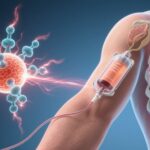Highlights
- Retatrutide, a triple agonist targeting GIP, GLP-1, and glucagon receptors, induces superior reductions in total body fat and liver fat compared with placebo and active controls in type 2 diabetes and metabolic-associated steatotic liver disease (MASLD).
- Lean mass loss is proportionate to weight loss, aligning with other anti-obesity therapies, alleviating concerns regarding excessive lean mass reduction.
- Retatrutide demonstrates robust improvements in metabolic parameters, including insulin sensitivity and lipid metabolism, with an acceptable safety profile.
Clinical Background and Disease Burden
Type 2 diabetes (T2D) and MASLD (previously termed NAFLD) are highly prevalent and interconnected chronic diseases with significant morbidity and mortality. Both conditions are characterized by insulin resistance, ectopic fat accumulation, and increased cardiovascular risk. Existing therapies for weight and liver fat reduction are limited in efficacy, and preservation of lean mass during weight loss remains a clinical priority, particularly in populations vulnerable to sarcopenia or frailty. The need for effective, multi-targeted interventions is underscored by the global increase in obesity and its complications.
Research Methodology
The efficacy and safety of retatrutide were investigated in two rigorously designed phase 2 randomized, double-blind, placebo-controlled trials:
- Study 1: Coskun et al. (Lancet Diabetes Endocrinol. 2025) evaluated body composition changes over 36 weeks in T2D patients (n=189 for substudy) treated with weekly subcutaneous retatrutide (0.5–12 mg), dulaglutide (1.5 mg), or placebo. The primary endpoint was percent change in total body fat mass by dual-energy X-ray absorptiometry (DXA).
- Study 2: Sanyal et al. (Nat Med. 2024) assessed retatrutide’s effect on liver fat (LF) in MASLD patients (n=98) with ≥10% baseline liver fat, randomizing participants to retatrutide (1, 4, 8, or 12 mg) or placebo for 48 weeks (primary LF endpoint at 24 weeks).
Key eligibility included adult age, stable bodyweight, and adequate baseline metabolic parameters. Safety analyses included all participants who received at least one dose of study drug. Both studies were conducted in accordance with Good Clinical Practice and registered on ClinicalTrials.gov (NCT04867785, NCT04881760).
Key Findings
Body Composition in T2D:
- Retatrutide produced dose-dependent reductions in total body fat mass: 4.9% (0.5 mg), 15.2% (4 mg), 26.1% (8 mg), and 23.2% (12 mg) at 36 weeks, compared to 4.5% with placebo and 2.6% with dulaglutide 1.5 mg.
- Statistically significant differences from placebo were observed at higher doses (4 mg: -10.7%, p=0.0013; 8 mg: -21.6%, p<0.0001; 12 mg: -18.7%, p<0.0001).
- The proportion of lean mass loss to total weight loss was similar to established anti-obesity pharmacotherapies, suggesting preservation of muscle mass relative to fat loss.
Liver Fat and Metabolic Outcomes in MASLD:
- At 24 weeks, mean relative change in liver fat was -42.9% (1 mg), -57.0% (4 mg), -81.4% (8 mg), and -82.4% (12 mg), versus +0.3% with placebo (all P<0.001).
- Normalization of liver fat (<5%) at 24 weeks was achieved in 27% (1 mg), 52% (4 mg), 79% (8 mg), and 86% (12 mg) of retatrutide groups, compared to 0% for placebo.
- Liver fat reductions correlated strongly with reductions in body weight, abdominal fat, and improvements in metabolic indices, including insulin sensitivity and lipid profiles.
Safety and Tolerability:
- Adverse event rates were similar between treatment groups and comparators. Gastrointestinal symptoms were most common but generally manageable.
- Serious adverse events were infrequent and not dose-dependent; no deaths were reported.
Mechanistic Insights
Retatrutide’s efficacy is attributed to its triple agonism at GIP, GLP-1, and glucagon receptors, targeting complementary metabolic pathways:
- GLP-1 receptor agonism promotes satiety, enhances glucose-dependent insulin secretion, and delays gastric emptying.
- GIP receptor agonism synergizes with GLP-1 for greater insulinotropic and weight-reducing effects.
- Glucagon receptor agonism increases energy expenditure and facilitates hepatic lipid mobilization.
The profound reduction in both body and liver fat, along with favorable changes in metabolic parameters, supports biological plausibility for retatrutide’s multi-hormonal approach in metabolic disease.
Expert Commentary
These studies represent a significant advance in metabolic disease pharmacotherapy. The magnitude of fat mass and liver fat reduction, coupled with lean mass preservation, is clinically meaningful for high-risk populations. Expert consensus, including recent guideline updates, increasingly supports the use of multi-receptor agonists for obesity and related metabolic disorders, particularly when weight loss alone is insufficient to address comorbidities such as MASLD.
Controversies and Limitations
Limitations include moderate sample sizes, relatively short follow-up (36–48 weeks), and population homogeneity (majority White, underrepresentation of Asian and Black cohorts). Long-term data on cardiovascular outcomes, durability of effect, and rare adverse events remain outstanding. The studies were funded by the drug manufacturer, warranting continued independent evaluation.
Conclusion
Retatrutide demonstrates potent, dose-dependent reductions in body fat and liver fat in patients with type 2 diabetes and MASLD, with a safety profile comparable to established therapies. These findings support retatrutide’s role as a promising next-generation metabolic therapy. Ongoing phase 3 studies and post-marketing surveillance are needed to determine long-term benefits and risks.
References
1. Coskun T, Wu Q, Schloot NC, Haupt A, Milicevic Z, Khouli C, Harris C. Effects of retatrutide on body composition in people with type 2 diabetes: a substudy of a phase 2, double-blind, parallel-group, placebo-controlled, randomised trial. Lancet Diabetes Endocrinol. 2025 Aug;13(8):674-684. doi: 10.1016/S2213-8587(25)00092-0.
2. Sanyal AJ, Kaplan LM, Frias JP, Brouwers B, Wu Q, Thomas MK, Harris C, Schloot NC, Du Y, Mather KJ, Haupt A, Hartman ML. Triple hormone receptor agonist retatrutide for metabolic dysfunction-associated steatotic liver disease: a randomized phase 2a trial. Nat Med. 2024 Jul;30(7):2037-2048. doi: 10.1038/s41591-024-03018-2.



